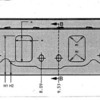quote:
If I were looking at doing this swap, I would drop the additional cash needed to buy a set of the CHI 4V heads.
Good advice George. It would take less time to swap the heads than prep the manifold, and this way, it can still be applied to a 4V head Cleveland for which it was designed.
quote:
You are not going to notice a difference in performance between the two cylinder heads.
I would agree, but would add that you're unlikely to realize IR performance characteristics without a purpose ground cam.
quote:
.....the headache of owning an IR system is not for you.
Now, now, George; tuning is pleasure not pain!

All the best,
Kelly


